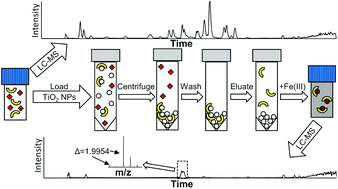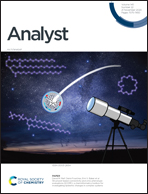Siderophore purification with titanium dioxide nanoparticle solid phase extraction†
Abstract
Siderophores are metal chelators produced by microorganisms to facilitate binding and uptake of iron. The isolation and characterization of siderophores are impeded by typically low siderophore yields and the complexity of siderophore-containing extracts generated with traditional purification methods. We investigated titanium dioxide nanoparticle solid-phase extraction (TiO2 NP SPE) as a technique to selectively concentrate and purify siderophores from complex matrices for subsequent LC-MS detection and identification. TiO2 NP SPE showed a high binding capacity (15.7 ± 0.2 μmol mg−1 TiO2) for the model siderophore desferrioxamine B (DFOB) and proved robust to pH changes and the presence of EDTA. These are significant advances in comparison to immobilized metal affinity chromatography (IMAC). The TiO2 NP SPE was highly selective and recovered 77.6 ± 6.2% of DFOB spiked to a compositionally complex bacterial culture supernatant. The simple clean-up procedure removed the majority of contaminants and allowed direct detection of siderophores from the LC-MS base peak chromatogram. The ‘untargeted’ purification and analysis of an untreated supernatant of iron-deprived bacterial culture allowed for the direct identification of two known and three novel ferrioxamines. Thus, TiO2 NP SPE in combination with LC-MS offers great potential as a discovery platform for the purification and subsequent quantification or identification of novel siderophores of microbial origin.



 Please wait while we load your content...
Please wait while we load your content...